The washable flexographic printing plate market is anticipated to rise from USD 871.1 million in 2025 to USD 1,516.4 million by 2035, reflecting a CAGR of 5.7%. When evaluated against macroeconomic indicators, the elasticity of growth highlights how the industry responds to variables such as GDP expansion, trade flows, and shifts in manufacturing activity. Stronger economic performance stimulates demand for consumer goods, packaging, and labeling, which directly increases adoption of flexographic printing technologies. The periods of slower economic growth create measured demand but are balanced by ongoing replacement needs and compliance with environmental regulations favoring washable plates.
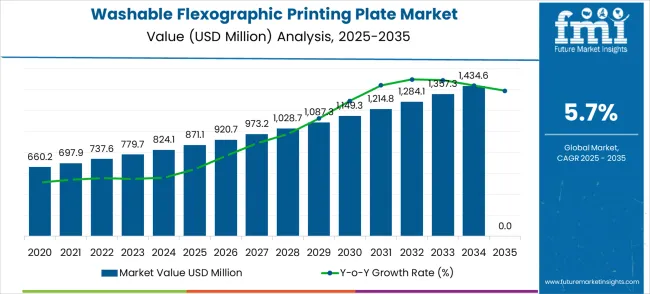
Elasticity also reflects raw material pricing trends, energy costs, and capital expenditure cycles within the printing and packaging industries. High elasticity is visible when economic growth drives higher consumption, prompting faster adoption of cost-efficient and eco-friendly printing solutions. During weaker macroeconomic conditions, growth remains resilient due to regulatory pushes toward sustainable production practices and the cost savings washable plates provide over traditional alternatives. This interaction between macro drivers and sector-specific demand ensures that even in fluctuating environments, the market maintains forward momentum. The balance of cyclical influences and structural trends underscores the steady yet adaptive trajectory of this segment over the forecast horizon.
| Metric | Value |
|---|---|
| Estimated Value in (2025E) | USD 871.1 million |
| Forecast Value in (2035F) | USD 1,516.4 million |
| Forecast CAGR (2025 to 2035) | 5.7% |
The washable flexographic printing plate market is divided into food and beverage packaging (39%), pharmaceuticals and healthcare labeling (24%), household and personal care products (18%), industrial goods packaging (11%), and specialty printing applications including corrugated displays and promotional materials (8%). Food and beverage packaging holds the largest share as washable plates deliver sharp impressions and support quick turnaround in high-volume printing. Pharmaceuticals use them to ensure precise, compliant labeling. Household and personal care brands prefer washable plates for design flexibility and cleaner operations. Industrial packaging and specialty applications benefit from durability, consistent quality, and reduced downtime.
Ongoing innovations include eco-friendly resin formulations, faster plate-washing systems, and enhanced image resolution. Manufacturers are focusing on automated plate cleaning, higher plate durability, and compatibility with water-based inks to reduce environmental impact. Demand is expanding in flexible packaging, e-commerce-ready cartons, and specialty labels. Collaborations between plate makers, packaging converters, and brand owners drive tailored solutions for efficiency, clarity, and cost control, ensuring steady global adoption.
Market expansion is being supported by the increasing global focus on sustainable printing practices and the corresponding need for eco-friendly printing solutions that can reduce waste generation and operational costs while maintaining superior print quality across various packaging and labeling applications. Modern printing facilities are increasingly focused on implementing sustainable solutions that can deliver consistent print results, minimize environmental impact, and provide cost-effective operations through extended plate lifecycles and reduced waste disposal requirements. Washable flexographic printing plates' proven ability to deliver excellent print quality, extended durability, and environmental sustainability makes them essential components for contemporary sustainable printing and packaging production applications.
Printing operators' preference for solutions that combine for innovative, sustainable printing technology implementations. The rising influence of sustainability reporting requirements and corporate environmental responsibility is also contributing to increased adoption of washable plates that can provide reliable printing solutions without compromising ecological performance or operational quality.
The market is segmented by base material, application, and region. By base material, the market is divided into metal base, polyester base, and others. Based on application, the market is categorized into food packaging and label printing. Regionally, the market is divided into North America, Europe, East Asia, South Asia & Pacific, Latin America, and the Middle East & Africa.
The polyester base segment is projected to account for 52.0% of the washable flexographic printing plate market in 2025, reaffirming its position as the leading base material category. Printing facilities increasingly utilize polyester-based washable plates for their superior flexibility, excellent chemical resistance, and optimal performance in high-volume printing applications across food packaging and label production. Polyester-based technology's established processing compatibility and consistent performance characteristics directly address the printing industry requirements for reliable print quality and operational efficiency in demanding production environments.
This base material segment forms the foundation of modern washable printing plate operations, as it represents the substrate material with the greatest versatility and established market demand across multiple printing applications and production requirements. Manufacturer investments in enhanced polyester formulations and surface treatment technologies continue to strengthen adoption among printing facilities. With printing companies prioritizing durability and print consistency, polyester-based washable plates align with both operational performance objectives and sustainability requirements, making them the central component of comprehensive sustainable printing strategies.
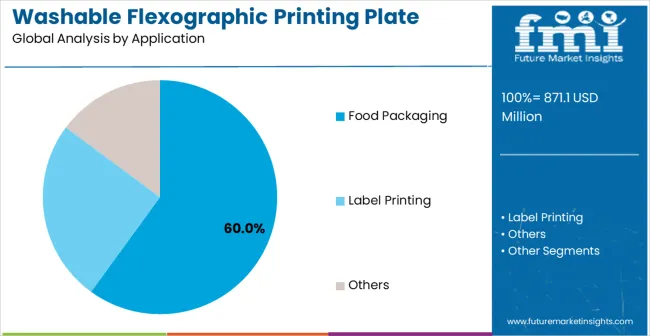
Food packaging applications are projected to represent 60.0% of washable flexographic printing plate demand in 2025, underscoring their critical role as the primary consumers of sustainable printing solutions for food product packaging, consumer goods labeling, and retail packaging applications. Food packaging manufacturers prefer washable flexographic plates for their food-safe characteristics, superior print quality, and ability to enhance packaging production while reducing operational costs and environmental impact. Positioned as essential components for modern food packaging production, washable plates offer both printing advantages and sustainability benefits.
The segment is supported by continuous innovation in food packaging technologies and the growing availability of specialized plate formulations that enable superior print performance with enhanced food safety compliance and sustainability features. The food packaging manufacturers are investing in sustainable printing systems to support comprehensive packaging optimization and environmental responsibility initiatives. As food packaging regulations become more stringent and sustainability requirements increase, food packaging will continue to dominate the application market while supporting advanced sustainable printing technology utilization and production optimization strategies.
The washable flexographic printing plate market is advancing steadily due to increasing sustainability requirements in printing operations and growing demand for cost-effective printing solutions that provide superior environmental performance and operational efficiency across diverse packaging and labeling applications. However, the market faces challenges, including higher initial investment costs, specialized washing equipment requirements, and the need for modified workflow processes and operator training. Innovation in plate materials and washing technologies continues to influence product development and market expansion patterns.
The growing adoption of advanced polymer materials and eco-friendly formulations is enabling manufacturers to produce sophisticated washable flexographic plates with enhanced durability, improved print quality, and superior washing characteristics. Advanced plate materials provide better performance while allowing extended reuse cycles and consistent print results across various printing applications. Manufacturers are increasingly recognizing the competitive advantages of advanced material technologies for product differentiation and premium market positioning.
Modern washable flexographic plate producers are incorporating digital workflow management and automated washing systems to enhance operational efficiency, optimize plate lifecycle management, and provide comprehensive process monitoring and quality control. These technologies improve printing productivity while enabling new capabilities, including predictive maintenance and automated quality assurance. Advanced workflow integration also allows manufacturers to support premium service positioning and enhanced functionality beyond traditional plate manufacturing processes.
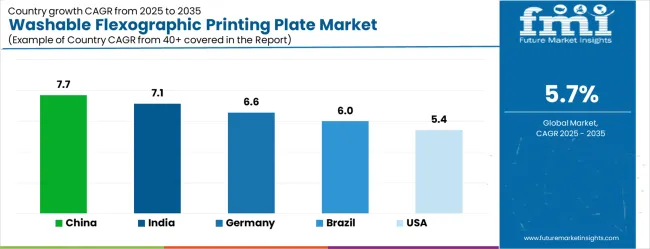
| Country | CAGR (2025-2035) |
|---|---|
| China | 7.7% |
| India | 7.1% |
| Germany | 6.6% |
| Brazil | 6.0% |
| USA | 5.4% |
| U.K. | 4.8% |
| Japan | 4.3% |
The washable flexographic printing plate market is experiencing moderate growth globally, with China leading at a 7.7% CAGR through 2035, driven by the rapidly expanding packaging industry, growing environmental regulations, and significant investment in sustainable printing technology infrastructure. India follows at 7.1%, supported by industrial development, increasing packaging demand, and growing adoption of eco-friendly printing technologies in manufacturing facilities. Germany shows growth at 6.6%, prioritizing sustainability, innovation and premium printing equipment development. Brazil records 6.0%, focusing on packaging industry expansion and environmental regulation compliance. The USA demonstrates 5.4% growth, prioritizing sustainable printing technologies and packaging innovation. The U.K. exhibits 4.8% growth, prioritizing environmental compliance and printing industry modernization. Japan shows 4.3% growth, supported by advanced printing processes and sustainability technology innovation.
The report covers an in-depth analysis of 40+ countries, Top-performing countries are highlighted below.
The washable flexographic printing plate market in China is projected to exhibit strong growth with a CAGR of 7.7% through 2035, driven by rapidly expanding packaging manufacturing infrastructure and significant government investment in environmental protection technologies supported by industrial sustainability initiatives and circular economy development programs. The country's massive packaging production capacity and increasing prioritizing on sustainable manufacturing practices are creating substantial demand for eco-friendly printing solutions. Major packaging manufacturers and printing companies are establishing comprehensive sustainable printing capabilities to serve both domestic and international markets.
The washable flexographic printing plate market in India is expanding at a CAGR of 7.1%, supported by the country's rapid industrial development, growing packaging industry, and increasing adoption of sustainable printing technologies in manufacturing and consumer goods production. The country's expanding packaging infrastructure and rising focus on environmental compliance are driving demand for washable printing solutions. International printing technology providers and domestic manufacturers are establishing extensive production and distribution capabilities to address the growing demand for sustainable printing equipment.
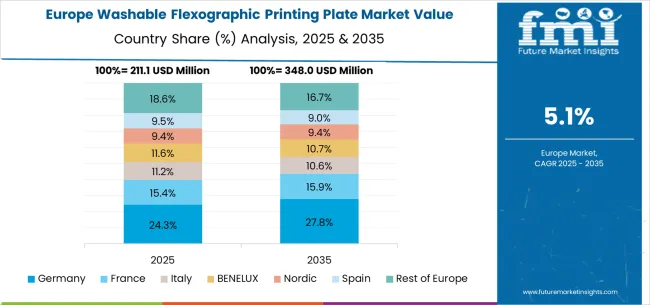
The washable flexographic printing plate market in Germany is expanding at a CAGR of 6.6%, supported by the country's advanced printing technology sector, strong prioritizing on environmental sustainability, and robust demand for high-quality sustainable printing solutions among precision packaging and premium label manufacturers. The nation's mature printing industry and commitment to ecological excellence are driving sophisticated sustainable printing technology integration throughout production facilities. Leading technology companies and printing equipment manufacturers are investing extensively in premium product development and advanced sustainable technologies to serve both domestic and European markets.
The washable flexographic printing plate market in Brazil is growing at a CAGR of 6.0%, driven by expanding packaging manufacturing infrastructure, strengthening environmental regulations, and increasing investment in sustainable printing technology adoption across major production regions. The country's developing packaging sector and increasing ecological compliance requirements are supporting demand for sustainable printing technologies. Printing technology providers and packaging manufacturers are establishing comprehensive capabilities to serve growing domestic demand and regional export opportunities.
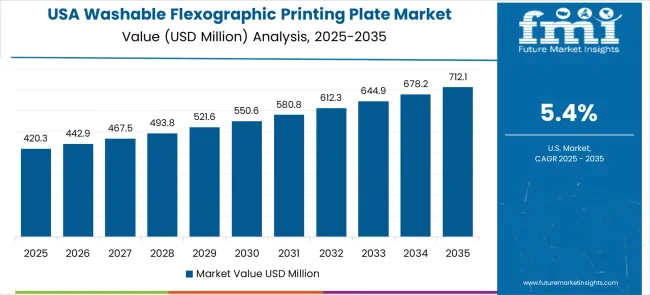
The washable flexographic printing plate market in the USA is expanding at a CAGR of 5.4%, supported by the country's advanced packaging industry, strong focus on environmental sustainability, and established demand for innovative printing solutions among leading packaging manufacturers and consumer goods companies. The USA's mature printing technology sector and leadership in packaging innovation are driving demand for sophisticated, sustainable printing systems focusing on environmental performance and operational optimization. Technology providers are investing in comprehensive capabilities to serve food packaging, consumer goods, and specialty printing markets with innovative, sustainable solutions.
The washable flexographic printing plate market in the U.K. is growing at a CAGR of 4.8%, driven by the country's environmental compliance requirements, prioritizing on printing industry modernization, and strong demand for sustainable printing solutions in packaging and labeling applications. The U.K.'s established printing industry heritage and commitment to environmental excellence are supporting investment in advanced sustainable printing capabilities. Industry leaders are establishing comprehensive sustainability programs to serve both domestic and European markets with premium eco-friendly printing solutions.
The washable flexographic printing plate market in Japan is expanding at a CAGR of 4.3%, supported by the country's focus on advanced printing processes, sustainability technology development, and strong focus on operational efficiency and environmental responsibility in packaging production. Japan's sophisticated printing industry and commitment to technological innovation are driving demand for advanced sustainable printing technologies, including high-performance washable systems and integrated environmental solutions. Leading printing technology companies are investing in specialized capabilities to serve packaging, consumer goods, and specialty printing segments with premium sustainable printing equipment.
The washable flexographic printing plate market in Europe is projected to grow from USD 191.6 million in 2025 to USD 333.6 million by 2035, registering a CAGR of 5.7% over the forecast period. Germany is expected to maintain its leadership position with a 31.0% market share in 2025, declining slightly to 30.5% by 2035, supported by its strong printing technology sector, advanced packaging industry, and comprehensive sustainable printing technology supply network serving major European markets.
France follows with a 17.0% share in 2025, projected to reach 17.5% by 2035, driven by robust demand for sustainable printing solutions in food packaging, consumer goods labeling, and premium packaging applications, combined with established environmental regulations promoting eco-friendly printing technologies. The United Kingdom holds a 15.5% share in 2025, expected to decrease to 15.0% by 2035, supported by strong environmental compliance requirements but facing challenges from economic conditions and competitive pressures from continental suppliers. Italy commands a 12.5% share in 2025, projected to reach 12.7% by 2035, while Spain accounts for 9.0% in 2025, expected to reach 9.3% by 2035. The Netherlands maintains a 4.5% share in 2025, growing to 4.7% by 2035. The Rest of Europe region, including Nordic countries, Eastern Europe, Portugal, Belgium, Switzerland, and Austria, is anticipated to maintain steady growth, with its collective share remaining at 10.5% to 10.3% by 2035, attributed to consistent adoption of sustainable printing technologies in Nordic countries and growing packaging activities across Eastern European markets implementing environmental modernization programs.
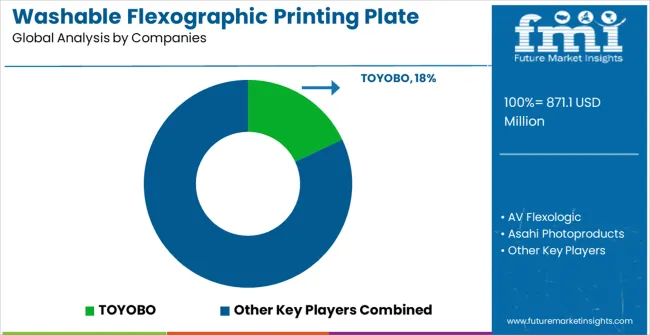
The washable flexographic printing plate market is characterized by competition among established printing plate manufacturers, specialized sustainable printing solution providers, and integrated printing technology companies. Companies are investing in advanced material development, sustainable manufacturing processes, product performance optimization, and comprehensive service portfolios to deliver durable, high-quality, and environmentally-friendly printing solutions. Innovation in plate materials, washing technologies, and sustainable manufacturing practices is central to strengthening market position and competitive advantage.
TOYOBO leads the market with a strong market share, offering comprehensive printing plate solutions with a focus on sustainable and high-performance applications. AV Flexologic provides specialized flexographic printing technologies with prioritizing on washable solutions and operational efficiency. Asahi Photoproducts delivers innovative printing plate systems with a focus on sustainability and advanced printing performance. Sumitomo Riko Company Limited specializes in advanced polymer materials and printing plate technologies for diverse applications. Flint Group focuses on comprehensive printing solutions prioritizing integrated sustainability features. DUPONT offers advanced material technologies with emphasis on performance and environmental responsibility.
The washable flexographic printing plate market, valued at USD 871.1 million in 2025 and projected to reach USD 1,516.4 million by 2035 at a 5.7% CAGR, represents a specialized sustainable printing segment driven by environmental regulations and cost-reduction imperatives. Dominated by polyester-based plates (52.0% market share) and food packaging applications (60.0% market share), the market faces challenges including higher initial investment costs, specialized washing equipment requirements, and workflow modification needs. Success requires coordinated efforts across plate manufacturers, printing companies, packaging producers, equipment suppliers, and environmental regulators.
How Governments Could Support Sustainable Printing Innovation and Environmental Compliance?
How Industry Associations Could Advance Technology Adoption and Best Practices?
How Plate Manufacturers and Technology Developers Could Drive Innovation?
How Printing Companies and Packaging Producers Could Optimize Implementation?
How Investors and Financial Enablers Could Support Market Growth?
| Items | Values |
|---|---|
| Quantitative Units (2025) | USD 871.1 million |
| Base Material | Metal Base, Polyester Base, Others |
| Application | Food Packaging, Label Printing |
| Regions Covered | North America, Europe, East Asia, South Asia & Pacific, Latin America, Middle East & Africa |
| Countries Covered | United States, Canada, United Kingdom, Germany, France, China, Japan, South Korea, India, Brazil, Australia and 40+ countries |
| Key Companies Profiled | TOYOBO, AV Flexologic, Asahi Photoproducts, Sumitomo Riko Company Limited, Flint Group, and DUPONT |
| Additional Attributes | Dollar sales by base material and application category, regional demand trends, competitive landscape, technological advancements in sustainable printing materials, washing technology innovation, process optimization integration, and supply chain optimization |
North America
Europe
East Asia
The global non-selective broadleaf herbicides market is estimated to be valued at USD 4,918.3 million in 2025.
The market size for the non-selective broadleaf herbicides market is projected to reach USD 8,165.4 million by 2035.
The non-selective broadleaf herbicides market is expected to grow at a 5.2% CAGR between 2025 and 2035.
The key product types in non-selective broadleaf herbicides market are glyphosate, glufosinate and others.
In terms of application, orchard segment to command 34.0% share in the non-selective broadleaf herbicides market in 2025.






Our Research Products

The "Full Research Suite" delivers actionable market intel, deep dives on markets or technologies, so clients act faster, cut risk, and unlock growth.

The Leaderboard benchmarks and ranks top vendors, classifying them as Established Leaders, Leading Challengers, or Disruptors & Challengers.

Locates where complements amplify value and substitutes erode it, forecasting net impact by horizon

We deliver granular, decision-grade intel: market sizing, 5-year forecasts, pricing, adoption, usage, revenue, and operational KPIs—plus competitor tracking, regulation, and value chains—across 60 countries broadly.

Spot the shifts before they hit your P&L. We track inflection points, adoption curves, pricing moves, and ecosystem plays to show where demand is heading, why it is changing, and what to do next across high-growth markets and disruptive tech

Real-time reads of user behavior. We track shifting priorities, perceptions of today’s and next-gen services, and provider experience, then pace how fast tech moves from trial to adoption, blending buyer, consumer, and channel inputs with social signals (#WhySwitch, #UX).

Partner with our analyst team to build a custom report designed around your business priorities. From analysing market trends to assessing competitors or crafting bespoke datasets, we tailor insights to your needs.
Supplier Intelligence
Discovery & Profiling
Capacity & Footprint
Performance & Risk
Compliance & Governance
Commercial Readiness
Who Supplies Whom
Scorecards & Shortlists
Playbooks & Docs
Category Intelligence
Definition & Scope
Demand & Use Cases
Cost Drivers
Market Structure
Supply Chain Map
Trade & Policy
Operating Norms
Deliverables
Buyer Intelligence
Account Basics
Spend & Scope
Procurement Model
Vendor Requirements
Terms & Policies
Entry Strategy
Pain Points & Triggers
Outputs
Pricing Analysis
Benchmarks
Trends
Should-Cost
Indexation
Landed Cost
Commercial Terms
Deliverables
Brand Analysis
Positioning & Value Prop
Share & Presence
Customer Evidence
Go-to-Market
Digital & Reputation
Compliance & Trust
KPIs & Gaps
Outputs
Full Research Suite comprises of:
Market outlook & trends analysis
Interviews & case studies
Strategic recommendations
Vendor profiles & capabilities analysis
5-year forecasts
8 regions and 60+ country-level data splits
Market segment data splits
12 months of continuous data updates
DELIVERED AS:
PDF EXCEL ONLINE
Flexographic Ink Market - Growth & Demand 2025 to 2035
Flexographic Printing Inks Market Size and Share Forecast Outlook 2025 to 2035
Flexographic Printing Machine Market Analysis, Size, Share & Forecast 2024 to 2034
Flexographic Printing Market Growth – Trends & Forecast 2024-2034
Flexographic Printing Plate Market Size and Share Forecast Outlook 2025 to 2035
Water-based Flexographic Printing Market Trends & Forecast 2024-2034
Plate Chain Elevator Market Size and Share Forecast Outlook 2025 to 2035
Platelet Shaker Market Size and Share Forecast Outlook 2025 to 2035
Plate and Frame Heat Exchanger Market Size and Share Forecast Outlook 2025 to 2035
Platelet Concentration Systems Market Size and Share Forecast Outlook 2025 to 2035
Platelet Rich Plasma Market Analysis - Size, Share, and Forecast Outlook 2025 to 2035
Plate Electrostatic Precipitator Market Size and Share Forecast Outlook 2025 to 2035
Platelet Function Test Market Report - Growth & Forecast 2025 to 2035
Plate Heat Exchanger Market Growth - Trends & Forecast 2025 to 2035
Plates Market
Tinplate Packaging Market Size and Share Forecast Outlook 2025 to 2035
Hotplate Stirrers Market Size and Share Forecast Outlook 2025 to 2035
Template Preparation Kits Market
Miniplate for Bone Fixation Market Size and Share Forecast Outlook 2025 to 2035
Drawplate Market Size and Share Forecast Outlook 2025 to 2035

Thank you!
You will receive an email from our Business Development Manager. Please be sure to check your SPAM/JUNK folder too.
Chat With
MaRIA